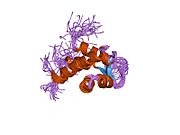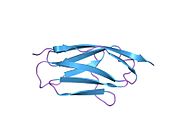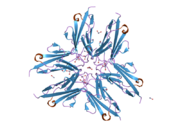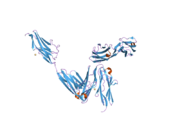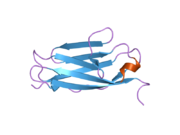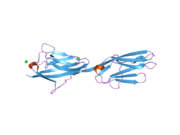Titin: Difference between revisions
removed unsourced content |
removed unsourced content |
||
| Line 4: | Line 4: | ||
--> |
--> |
||
{{PBB|geneid=7273}} |
{{PBB|geneid=7273}} |
||
'''Titin'''. It is important in the contraction of [[striated muscle]] tissues.<ref>{{OMIM|188840}}</ref><ref name= "Entrez_ 7273">{{cite web | title = Entrez Gene: TTN titin| url = http://www.ncbi.nlm.nih.gov/sites/entrez?Db=gene&Cmd=ShowDetailView&TermToSearch=7273| accessdate = }}</ref> |
'''Titin'''. It is important in the contraction of [[striated muscle]] tissues.<ref>{{OMIM|188840}}</ref><ref name= "Entrez_ 7273">{{cite web | title = Entrez Gene: TTN titin| url = http://www.ncbi.nlm.nih.gov/sites/entrez?Db=gene&Cmd=ShowDetailView&TermToSearch=7273| accessdate = }}</ref> |
||
== Structure == |
== Structure == |
||
Revision as of 18:47, 13 February 2010
Template:PBB Titin. It is important in the contraction of striated muscle tissues.[1][2]
Structure
Titin, which consists of 34,350 amino acids, is the largest known protein. The molecular weight of the mature protein is approximately 2,993,442.763 Da,[3] and it has a theoretical isoelectric point of 6.01.[4] The protein's empirical chemical formula is C132983H211861N36149O40883S693. It has a theoretical instability index (II) of 39.69, indicating that it would be stable in a test tube. The protein's in vivo half-life, the time it takes for half of the amount of protein in a cell to break down after its synthesis in the cell, is predicted to be approximately 30 hours (in mammalian reticulocytes).[5]
Titin consists primarily of a linear array of two types of modules (also referred to as protein domains): type I (fibronectin type III domain) and type II (immunoglobulin domain).[6] This linear array is further organized into two regions:
- N-terminal I-band
- acts as the elastic part of the molecule and is composed mainly of type II modules. More specifically the I-band contains two regions of tandem type II immunoglobulin domains on either side of a PEVK region that is rich in proline, glutamate, valine and lysine. Titin is found between the myosin thick filament and the Z disk.[7]
- C-terminal A-band
- is thought to act as a protein-ruler and possesses kinase activity. The A-band is composed of alternating type I and II modules with super-repeat segments. These have been shown to align to the 43nm axial repeats of myosin thick filaments with immunoglobulin domains correlating to Myosin crowns. [8]
Function
Titin is a large abundant protein of striated muscle. A N-terminal Z-disc region and a C-terminal M-line region bind to the Z-line and M-line of the sarcomere respectively so that a single titin molecule spans half the length of a sarcomere. Titin also contains binding sites for muscle associated proteins so it serves as an adhesion template for the assembly of contractile machinery in muscle cells. It has also been identified as a structural protein for chromosomes. Considerable variability exists in the I-band, the M-line and the Z-disc regions of titin. Variability in the I-band region contributes to the differences in elasticity of different titin isoforms and, therefore, to the differences in elasticity of different muscle types. Of the many titin variants identified, five for which complete transcript information is available are described.[2][9]
Titin interacts with many sarcomeric proteins including:[10]
- Z line region: telethonin and alpha-actinin
- I band region: calpain-3 and obscurin
- M line region: myosin-binding protein C, calmodulin 1, CAPN3, and MURF1
Clinical relevance
Mutations in this gene are associated with familial hypertrophic cardiomyopathy 9[11][12] and tibial muscular dystrophy.[13] Autoantibodies to titin are produced in patients with the autoimmune disease scleroderma.[14]
Linguistic significance
As the largest known protein, titin also has the longest IUPAC name. The full chemical name, which starts methionyl... and ends ...isoleucine, contains 189,819 letters and is sometimes stated to be the longest word in the English language, or any language.[15] However, professional dictionary writers regard generic names of chemical compounds as verbal formulae rather than English words.[16]
Additional images
-
Sliding filament model of muscle contraction. (Titin labeled at upper right.)
Interactions
Titin has been shown to interact with Telethonin,[17][18][19][20] FHL2,[21] OBSCN,[22] ANK1,[23] ANKRD1,[24] CAPN3,[25][26] ANKRD23[24] and TRIM63.[27]
References
- ^ Online Mendelian Inheritance in Man (OMIM): 188840
- ^ a b "Entrez Gene: TTN titin".
- ^ Result of Molecular Weight Calculation
- ^ "ExPASy-calculated pI for titin". Retrieved 2007-08-26.
- ^ "Swiss-Prot Protein knowledgebase, main entry". Retrieved 2006-05-04.
- ^ Labeit S, Kolmerer B (1995). "Titins: giant proteins in charge of muscle ultrastructure and elasticity". Science. 270 (5234): 293–6. PMID 7569978.
{{cite journal}}: Unknown parameter|month=ignored (help) - ^ Wang K, McCarter R, Wright J, Beverly J, Ramirez-Mitchell R (1991). "Regulation of skeletal muscle stiffness and elasticity by titin isoforms: a test of the segmental extension model of resting tension". Proc. Natl. Acad. Sci. U.S.A. 88 (16): 7101–5. PMC 52241. PMID 1714586.
{{cite journal}}: Unknown parameter|month=ignored (help)CS1 maint: multiple names: authors list (link) - ^ Bennett PM, Gautel M (1996). "Titin domain patterns correlate with the axial disposition of myosin at the end of the thick filament". J Mol Biol. 259 (5): 896–903. PMID 8683592.
{{cite journal}}: Unknown parameter|month=ignored (help) - ^ Labeit S, Barlow DP, Gautel M, Gibson T, Holt J, Hsieh CL, Francke U, Leonard K, Wardale J, Whiting A, Trinick J (1990). "A regular pattern of two types of 100-residue motif in the sequence of titin". Nature. 345 (6272): 273–6. doi:10.1038/26926a0. PMID 2129545.
{{cite journal}}: Unknown parameter|month=ignored (help)CS1 maint: multiple names: authors list (link) - ^ Bang ML, Centner T, Fornoff F, Geach AJ, Gotthardt M, McNabb M, Witt CC, Labeit D, Gregorio CC, Granzier H, Labeit S (2001). "The complete gene sequence of titin, expression of an unusual approximately 700-kDa titin isoform, and its interaction with obscurin identify a novel Z-line to I-band linking system". Circ. Res. 89 (11): 1065–72. doi:10.1161/hh2301.100981. PMID 11717165.
{{cite journal}}: Unknown parameter|month=ignored (help)CS1 maint: multiple names: authors list (link) - ^ Siu BL, Niimura H, Osborne JA, Fatkin D, MacRae C, Solomon S, Benson DW, Seidman JG, Seidman CE (1999). "Familial dilated cardiomyopathy locus maps to chromosome 2q31". Circulation. 99 (8): 1022–6. PMID 10051295.
{{cite journal}}: Unknown parameter|month=ignored (help)CS1 maint: multiple names: authors list (link) - ^ Itoh-Satoh M, Hayashi T, Nishi H, Koga Y, Arimura T, Koyanagi T, Takahashi M, Hohda S, Ueda K, Nouchi T, Hiroe M, Marumo F, Imaizumi T, Yasunami M, Kimura A (2002). "Titin mutations as the molecular basis for dilated cardiomyopathy". Biochem. Biophys. Res. Commun. 291 (2): 385–93. doi:10.1006/bbrc.2002.6448. PMID 11846417.
{{cite journal}}: Unknown parameter|month=ignored (help)CS1 maint: multiple names: authors list (link) - ^ Hackman P, Vihola A, Haravuori H, Marchand S, Sarparanta J, De Seze J, Labeit S, Witt C, Peltonen L, Richard I, Udd B (2002). "Tibial muscular dystrophy is a titinopathy caused by mutations in TTN, the gene encoding the giant skeletal-muscle protein titin". Am. J. Hum. Genet. 71 (3): 492–500. doi:10.1086/342380. PMC 379188. PMID 12145747.
{{cite journal}}: Unknown parameter|month=ignored (help)CS1 maint: multiple names: authors list (link) - ^ Machado C, Sunkel CE, Andrew DJ (1998). "Human autoantibodies reveal titin as a chromosomal protein". J. Cell Biol. 141 (2): 321–33. doi:10.1083/jcb.141.2.321. PMC 2148454. PMID 9548712.
{{cite journal}}: Unknown parameter|month=ignored (help)CS1 maint: multiple names: authors list (link) - ^ "What is the longest word in the English language?". CliffsNotes.com. Retrieved 2009-05-26.
- ^ Oxford Word and Language Service team. "Ask the experts - What is the longest English word?". AskOxford.com / Oxford University Press. Retrieved 2008-01-13.
- ^ Gregorio, C C (1998). "The NH2 terminus of titin spans the Z-disc: its interaction with a novel 19-kD ligand (T-cap) is required for sarcomeric integrity". J. Cell Biol. 143 (4). UNITED STATES: 1013–27. ISSN 0021-9525. PMID 9817758.
{{cite journal}}: Check date values in:|year=(help); Cite has empty unknown parameters:|laydate=,|laysource=, and|laysummary=(help); Unknown parameter|coauthors=ignored (|author=suggested) (help); Unknown parameter|month=ignored (help); Unknown parameter|quotes=ignored (help) - ^ Mayans, O (1998). "Structural basis for activation of the titin kinase domain during myofibrillogenesis". Nature. 395 (6705). ENGLAND: 863–9. doi:10.1038/27603. ISSN 0028-0836. PMID 9804415.
{{cite journal}}: Check date values in:|year=(help); Cite has empty unknown parameters:|laydate=,|laysource=, and|laysummary=(help); Unknown parameter|coauthors=ignored (|author=suggested) (help); Unknown parameter|month=ignored (help); Unknown parameter|quotes=ignored (help) - ^ Zou, Peijian (2003). "Solution scattering suggests cross-linking function of telethonin in the complex with titin". J. Biol. Chem. 278 (4). United States: 2636–44. doi:10.1074/jbc.M210217200. ISSN 0021-9258. PMID 12446666.
{{cite journal}}: Check date values in:|year=(help); Cite has empty unknown parameters:|laydate=,|laysource=, and|laysummary=(help); Unknown parameter|coauthors=ignored (|author=suggested) (help); Unknown parameter|month=ignored (help); Unknown parameter|quotes=ignored (help)CS1 maint: unflagged free DOI (link) - ^ Mues, A (1998). "Two immunoglobulin-like domains of the Z-disc portion of titin interact in a conformation-dependent way with telethonin". FEBS Lett. 428 (1–2). NETHERLANDS: 111–4. ISSN 0014-5793. PMID 9645487.
{{cite journal}}: Check date values in:|year=(help); Cite has empty unknown parameters:|laydate=,|laysource=, and|laysummary=(help); Unknown parameter|coauthors=ignored (|author=suggested) (help); Unknown parameter|month=ignored (help); Unknown parameter|quotes=ignored (help) - ^ Lange, Stephan (2002). "Subcellular targeting of metabolic enzymes to titin in heart muscle may be mediated by DRAL/FHL-2". J. Cell. Sci. 115 (Pt 24). England: 4925–36. ISSN 0021-9533. PMID 12432079.
{{cite journal}}: Check date values in:|year=(help); Cite has empty unknown parameters:|laydate=,|laysource=, and|laysummary=(help); Unknown parameter|coauthors=ignored (|author=suggested) (help); Unknown parameter|month=ignored (help); Unknown parameter|quotes=ignored (help) - ^ Young, P (2001). "Obscurin, a giant sarcomeric Rho guanine nucleotide exchange factor protein involved in sarcomere assembly". J. Cell Biol. 154 (1). United States: 123–36. ISSN 0021-9525. PMID 11448986.
{{cite journal}}: Check date values in:|year=(help); Cite has empty unknown parameters:|laydate=,|laysource=, and|laysummary=(help); Unknown parameter|coauthors=ignored (|author=suggested) (help); Unknown parameter|month=ignored (help); Unknown parameter|quotes=ignored (help) - ^ Kontrogianni-Konstantopoulos, Aikaterini (2003). "The hydrophilic domain of small ankyrin-1 interacts with the two N-terminal immunoglobulin domains of titin". J. Biol. Chem. 278 (6). United States: 3985–91. doi:10.1074/jbc.M209012200. ISSN 0021-9258. PMID 12444090.
{{cite journal}}: Check date values in:|year=(help); Cite has empty unknown parameters:|laydate=,|laysource=, and|laysummary=(help); Unknown parameter|coauthors=ignored (|author=suggested) (help); Unknown parameter|month=ignored (help); Unknown parameter|quotes=ignored (help)CS1 maint: unflagged free DOI (link) - ^ a b Miller, Melanie K (2003). "The muscle ankyrin repeat proteins: CARP, ankrd2/Arpp and DARP as a family of titin filament-based stress response molecules". J. Mol. Biol. 333 (5). England: 951–64. ISSN 0022-2836. PMID 14583192.
{{cite journal}}: Check date values in:|year=(help); Cite has empty unknown parameters:|laydate=,|laysource=, and|laysummary=(help); Unknown parameter|coauthors=ignored (|author=suggested) (help); Unknown parameter|month=ignored (help); Unknown parameter|quotes=ignored (help) - ^ Ono, Y (1998). "Functional defects of a muscle-specific calpain, p94, caused by mutations associated with limb-girdle muscular dystrophy type 2A". J. Biol. Chem. 273 (27). UNITED STATES: 17073–8. ISSN 0021-9258. PMID 9642272.
{{cite journal}}: Check date values in:|year=(help); Cite has empty unknown parameters:|laydate=,|laysource=, and|laysummary=(help); Unknown parameter|coauthors=ignored (|author=suggested) (help); Unknown parameter|month=ignored (help); Unknown parameter|quotes=ignored (help) - ^ Sorimachi, H (1995). "Muscle-specific calpain, p94, responsible for limb girdle muscular dystrophy type 2A, associates with connectin through IS2, a p94-specific sequence". J. Biol. Chem. 270 (52). UNITED STATES: 31158–62. ISSN 0021-9258. PMID 8537379.
{{cite journal}}: Check date values in:|year=(help); Cite has empty unknown parameters:|laydate=,|laysource=, and|laysummary=(help); Unknown parameter|coauthors=ignored (|author=suggested) (help); Unknown parameter|month=ignored (help); Unknown parameter|quotes=ignored (help) - ^ Centner, T (2001). "Identification of muscle specific ring finger proteins as potential regulators of the titin kinase domain". J. Mol. Biol. 306 (4). England: 717–26. doi:10.1006/jmbi.2001.4448. ISSN 0022-2836. PMID 11243782.
{{cite journal}}: Check date values in:|year=(help); Cite has empty unknown parameters:|laydate=,|laysource=, and|laysummary=(help); Unknown parameter|coauthors=ignored (|author=suggested) (help); Unknown parameter|month=ignored (help); Unknown parameter|quotes=ignored (help)
Further reading
External links
This article incorporates text from the United States National Library of Medicine, which is in the public domain.




